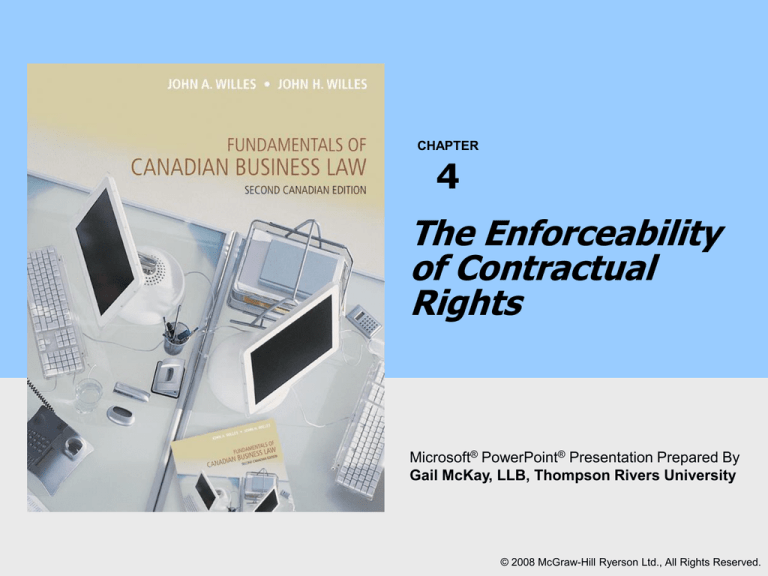
CHAPTER
4
The Enforceability
of Contractual
Rights
Microsoft® PowerPoint® Presentation Prepared By
Gail McKay, LLB, Thompson Rivers University
© 2008 McGraw-Hill Ryerson Ltd., All Rights Reserved.
OBJECTIVES
1. To learn what types of contracts must be in
writing or in a specific form to be
enforceable
2. To examine defences against enforceability
such as misrepresentation, mistake, undue
influence and duress
3. To identify the processes by which a
contract may be assigned
Fundamentals of Canadian Business Law, 2nd Canadian Edition
Slide 1-1
© 2008 McGraw-Hill Ryerson Ltd., All Rights Reserved.
THE REQUIREMENTS OF FORM AND WRITING
Contracts may be simple or formal
They need not take any specific type of form
Some types of contracts are mandated by legislation to be in a certain form,
such as deeds of land, mortgages, and powers of attorney
Contracts need not be in writing to be enforceable
Oral agreements are generally enforceable, with a few exceptions
Contracts may also be in electronic format
Several provinces have enacted legislation dealing with electronic contracts
Other provinces including Ontario allow deeds of land and mortgages to be in
electronic format and to be registered electronically in the counties that have
adopted electronic land registration
Fundamentals of Canadian Business Law, 2nd Canadian Edition Slide 1-2
© 2008 McGraw-Hill Ryerson Ltd., All Rights Reserved.
REQUIREMENTS OF FORM AND WRITING
The Statute of Frauds initiated a writing
requirement to demonstrate intention for certain
contracts
Examples of contracts associated with business
which are consequently required to be in writing
and signed include those respecting an interest in
land, guarantees, and agreements to assume
liability in tort law
Electronic documents meeting PIPEDA standards
for data scrutiny and integrity may be deemed
equivalent to writing
Fundamentals of Canadian Business Law, 2nd Canadian Edition
Slide 1-3
© 2008 McGraw-Hill Ryerson Ltd., All Rights Reserved.
Assumed Liability: The Guarantee
A guarantee is a promise by a third party to pay a creditor of the
principal if the debtor either refuses to or is unable to pay a debt
Guarantees must be in writing
Guarantees must be under seal, since there is no consideration flowing to
the guarantor
A creditor must exhaust its remedies against the principal debtor before it
may proceed against the guarantor
Fundamentals of Canadian Business Law, 2nd Canadian Edition Slide 1-4
© 2008 McGraw-Hill Ryerson Ltd., All Rights Reserved.
Assumed Liability: The Guarantee
There is a trend away from guarantees by banks and other lenders. They would
prefer that the potential guarantor be a co-signor or principal debtor
One of the reasons for this is that there are a number of defences available to
guarantors who are sued by the creditor
These defences include:
-Lack of independent legal advice
-An amendment to the principal debt without the consent of the guarantor
-A release of one guarantor is a release of all
Fundamentals of Canadian Business Law, 2nd Canadian Edition Slide 1-5
© 2008 McGraw-Hill Ryerson Ltd., All Rights Reserved.
ASSUMED LIABILITY: THE GUARANTEE
A guarantor is a third party to whom a creditor will turn if a principal debtor
defaults on the payment of a loan, but who is otherwise not primarily liable
Subrogation is the right of a guarantor to recover from the debtor any
payments made to the creditor on behalf of the debtor
A guarantor is liable for the whole amount of the loan even if there is more than
one guarantor; they are generally jointly and severally liable
The creditor may choose which guarantor it wishes to proceed against
It is up to the guarantor to seek contribution and indemnity from his coguarantors
An officer of a corporation who gives a personal guarantee cannot hide behind
the corporation's limited liability (more on this in later chapters)
Fundamentals of Canadian Business Law, 2nd Canadian Edition
Slide 1-6
© 2008 McGraw-Hill Ryerson Ltd., All Rights Reserved.
ASSUMED LIABILITY: IN TORT LAW
The assumption of liability by a third party
for the tort of another must be in writing and
must be signed to be enforceable
This type of agreement parallels the
assumption of liability in a guarantee
In place of a default upon a debt, the third
party arranges a settlement – out of court
compensation for an injured plaintiff
Fundamentals of Canadian Business Law, 2nd Canadian Edition
Slide 1-8
© 2008 McGraw-Hill Ryerson Ltd., All Rights Reserved.
WRITTEN MEMORANDUM REQUIREMENTS
To comply with the Statute of Frauds, no formal
document is necessary so long as the essential
terms of the contract are included and the
memorandum is signed
To comply with the Statute of Frauds, there generally is no requirement
that the contract be in a formal document
An exchange of letter may qualify
For example, Jim writes to Louis: "I would like to rent your apartment
located at 1213 Main Street for $250.00 per month." Louis writes back
confirming the arrangement
Fundamentals of Canadian Business Law, 2nd Canadian Edition
Slide 1-9
© 2008 McGraw-Hill Ryerson Ltd., All Rights Reserved.
Parol evidence rule
•A rule that oral evidence cannot be used to contradict
the terms of a written contract.
•As long as the terms of the contract are clear, the
courts will not admit any irrevelant evidence to prove
the terms of the contract
•If the contract is in writing, all of the agreed-upon
terms must be there
Fundamentals of Canadian Business Law, 2nd Canadian Edition Slide 1-10
© 2008 McGraw-Hill Ryerson Ltd., All Rights Reserved.
PAROL EVIDENCE RULE EXCEPTIONS
Condition precedent (CP) refers to an event or state of affairs that is
required before something else will occur.
In contract law, a condition precedent is an event which must occur,
unless its non-occurrence is excused, before performance under a
contract becomes due, i.e., before any contractual duty arises.
For instance, in the sentence "Jack will only go to heaven after he has
died," the death of Jack is a condition precedent to Jack going to
heaven.
The contract is in good standing, it is just that performance has been
suspended until the contemplated event occurs
This is one of the exceptions to the parol evidence rule
Fundamentals of Canadian Business Law, 2nd Canadian Edition Slide 1-11
© 2008 McGraw-Hill Ryerson Ltd., All Rights Reserved.
PAROL EVIDENCE RULE EXCEPTIONS
An implied term is another exception to the
parol evidence rule permitting the inclusion of
a term intended by the parties but omitted,
and normally included by business practice
A third exception is the collateral agreement,
one relevant to and supporting the original
agreement but having its own consideration
The parol evidence rule does not exclude the
later evidence of a subsequent agreement
Fundamentals of Canadian Business Law, 2nd Canadian Edition
Slide 1-12
© 2008 McGraw-Hill Ryerson Ltd., All Rights Reserved.
PAROL EVIDENCE RULE EXCEPTIONS
An implied term is another exception. It means it is As a matter
of fact.
Something that’s so obviously included that it didn’t need to be
mentioned in the contract.
If I agree to pay you $50 for a lawnmower, it probably wouldn’t occur to
us to write down that we mean fifty Canadian Dollars, as opposed to any
other sort of pound. That’s obvious to both of us.
(Beware of this point – it has to have been obvious to both parties – it’s
not enough to show that one party thought it was included, or that the
contract would have been more reasonable with the added term.)
Fundamentals of Canadian Business Law, 2nd Canadian Edition Slide 1-13
© 2008 McGraw-Hill Ryerson Ltd., All Rights Reserved.
PAROL EVIDENCE RULE EXCEPTIONS
The third exception is collateral agreement
A collateral agreement is a separate agreement which is somehow tied
to or related to the main agreement
The courts have held that, unless this collateral agreement is referred to
in the primary agreement, the collateral agreement must meet the
normal requirements of a contract and have separate consideration
Where a separate collateral agreement does exist, the courts will enforce
it even though it may conflict with the primary agreement
Fundamentals of Canadian Business Law, 2nd Canadian Edition Slide 1-14
© 2008 McGraw-Hill Ryerson Ltd., All Rights Reserved.
collateral agreement
For example
If 'Adam' enters into a construction contract with
'Bob' on the basis of which 'Bob' enters into a
contract with 'Charles' for a material used in
the construction, 'Adam' may have the right to sue
'Charles' for compensation if the material turns out
to be defective.
A collateral contract between three or more parties
requires the contracting parties to fulfill
their individual obligations to each party.
Fundamentals of Canadian Business Law, 2nd Canadian Edition Slide 1-15
© 2008 McGraw-Hill Ryerson Ltd., All Rights Reserved.
Subsequent Agreement
The parol evidence rule will not exclude evidence of
a subsequent agreement
The subsequent agreement represents a new
agreement made by the parties
Fundamentals of Canadian Business Law, 2nd Canadian Edition Slide 1-16
© 2008 McGraw-Hill Ryerson Ltd., All Rights Reserved.
AGREEMENTS IN PRINCIPLE
An agreement in principle confirms that the
parties have a view to making a formal
contract in the future
These letters of intent contain key issues but
not necessarily the detail expected in a formal
contract
To be enforceable, all terms must be certain
and the agreement must contemplate a second
contract as a condition to the present bargain
Fundamentals of Canadian Business Law, 2nd Canadian Edition
Slide 1-17
© 2008 McGraw-Hill Ryerson Ltd., All Rights Reserved.
LEARNING GOALS REVIEW
The Statute of Frauds requires certain types of contracts to be in writing
in order to be enforceable
These include: guarantees, assumed tort liability, interests in land
Some agreements must be in a particular form to be enforceable:
mortgages, deeds of land, etc.
A simple contract under the Statute of Frauds must identify the parties,
contain the terms of the agreement, and be signed by the responsible
parties
Other doctrines may permit other evidence of changes to the agreement,
such as doctrine of implied term, condition precedent, collateral
agreement, and subsequent agreement
Fundamentals of Canadian Business Law, 2nd Canadian Edition Slide 1-18
© 2008 McGraw-Hill Ryerson Ltd., All Rights Reserved.
FAILURE TO CREATE AN ENFORCEABLE
CONTRACT
oMISTAKE
oMISREPRESENTATION
oUNDUE INFLUENCE
oDURESS
oASSIGNMENT OF CONTRACTUAL RIGHTS
Fundamentals of Canadian Business Law, 2nd Canadian Edition Slide 1-19
© 2008 McGraw-Hill Ryerson Ltd., All Rights Reserved.
MISTAKE
A mistake is an error made by one or both of the parties that seriously
undermines a contract
Mistake generally refers to the situation where the parties have entered
into a contract which does not reflect their true intentions
For example, the parties may agree that Joshua will sell his truck to
Graham for $10,000. However, when the agreement is drawn up, a
couple of zeros were left off and it was recorded as $100.00. The courts
will not allow Graham to enforce this contract
Fundamentals of Canadian Business Law, 2nd Canadian Edition Slide 1-20
© 2008 McGraw-Hill Ryerson Ltd., All Rights Reserved.
MISTAKE
Unilateral and Mutual Mistakes
Mistakes may take one of two forms
A mistake may be made by only one party, which is called a unilateral
mistake
It may be made by all parties to the agreement, in which case it is a
mutual mistake
In the case of unilateral mistake, the other party not aware of the mistake
may take advantage of the innocent party
This is often very close to misrepresentation, which will be discussed later
Fundamentals of Canadian Business Law, 2nd Canadian Edition
Slide 1-21
© 2008 McGraw-Hill Ryerson Ltd., All Rights Reserved.
MISTAKE
Non est factum ("it is not my act") is a mistake as
to the very nature of a contract often arising from
having been misled, and sometimes allowing an
illiterate or infirm person to avoid liability
A failure of a party to examine the document does
not excuse it
Fundamentals of Canadian Business Law, 2nd Canadian Edition Slide 1-22
© 2008 McGraw-Hill Ryerson Ltd., All Rights Reserved.
MISTAKE
Rectification is a judicial correction of a
mistake when the intention of the parties was
clear and the written agreement does not
match the verbal arrangement
Fundamentals of Canadian Business Law, 2nd Canadian Edition
Slide 1-23
© 2008 McGraw-Hill Ryerson Ltd., All Rights Reserved.
MISREPRESENTATION
A misrepresentation is a false statement
which induces someone to enter a contract
Someone making an innocent
misrepresentation believes the material fact is
true but later discovers it is not, and the
remedy is rescission of the contract
Negligent misrepresentation occurs when
someone carelessly makes a statement,
without concern as to its truth or falsehood,
which induces another to enter a contract
Fundamentals of Canadian Business Law, 2nd Canadian Edition
Slide 1-24
© 2008 McGraw-Hill Ryerson Ltd., All Rights Reserved.
MISREPRESENTATION
To count as a misrepresentation, one must prove
that the statement is:
o False
o Clear and unambiguous
o Material to the contract
o Actually induced the aggrieved party to enter into
the contract, and
o Is concerned with a fact
Fundamentals of Canadian Business Law, 2nd Canadian Edition Slide 1-25
© 2008 McGraw-Hill Ryerson Ltd., All Rights Reserved.
INNOCENT MISREPRESENTATION
An innocent misrepresentation is a misrepresentation
of material fact that the maker honestly believed to
be true, but is discovered to be false after the parties
entered into the contract
It does not entitle the affected party to relief unless it
can be shown to be a material term of the contract
If it is a material term, then he/she may view the
contract as voidable and sue to have the action
rescinded
Fundamentals of Canadian Business Law, 2nd Canadian Edition Slide 1-26
© 2008 McGraw-Hill Ryerson Ltd., All Rights Reserved.
FRAUDULENT MISREPRESENTATION
In fraudulent misrepresentation cases, the
maker of the statement knows it is false and
intentionally misleads the other party
Similarly, if a statement is made recklessly,
without caring whether it is true or false,
fraudulent misrepresentation may also arise
Besides rescission, punitive damages are
available as punishment for the fraud, so long
as the victim does not accept any benefit after
the fraud is discovered
Fundamentals of Canadian Business Law, 2nd Canadian Edition
Slide 1-27
© 2008 McGraw-Hill Ryerson Ltd., All Rights Reserved.
MISREPRESENTATION: NONDISCLOSURE
Utmost good faith contracts are those which
impose a duty of disclosure
A special relationship of trust or confidence is
required under these contracts, such as a
contract for insurance
Non disclosure of material facts could seriously
affect the position of the other contracting
party, who is entitled to treat a nondisclosure
or partial disclosure as fraud
Fundamentals of Canadian Business Law, 2nd Canadian Edition
Slide 1-28
© 2008 McGraw-Hill Ryerson Ltd., All Rights Reserved.
UNDUE INFLUENCE
The concept of freedom to contract is altered
when one of the parties is under the power or
influence of the other to the extent that his or
her decision making is impacted
Fundamentals of Canadian Business Law, 2nd Canadian Edition
Slide 1-29
© 2008 McGraw-Hill Ryerson Ltd., All Rights Reserved.
RISK MANAGEMENT OF UNDUE INFLUENCE
Businesses should be alert to situations
which might give rise to a defence of undue
influence
When business persons realize that a potential
for undue influence exists, they should insist
upon evidence that the vulnerable party at
least had the opportunity to receive
independent legal advice regarding the
transaction
Fundamentals of Canadian Business Law, 2nd Canadian Edition
Slide 1-30
© 2008 McGraw-Hill Ryerson Ltd., All Rights Reserved.
DURESS
Duress is a threat or actual violence
perpetrated upon someone to induce him or
her to enter a contract
The type of harm may be physical,
psychological or a financial exploitation; and
the threat may be direct or indirect - made to
harm the contracting party him or herself or to
harm a member of his or her family
Such a contract may be held to be
unenforceable at the option of the victim
Fundamentals of Canadian Business Law, 2nd Canadian Edition
Slide 1-31
© 2008 McGraw-Hill Ryerson Ltd., All Rights Reserved.
ASSIGNMENT OF CONTRACTUAL RIGHTS
The privity of contract rule states that only the
parties to a contract can enforce the contract or be
liable under it
If Anne-Marie and Paige were the only parties to the
contract, William could not sue Anne-Marie if she
failed in her part of the bargain, even if William was
depending upon Anne-Marie's performance in her
contract with Paige
Fundamentals of Canadian Business Law, 2nd Canadian Edition
Slide 1-33
© 2008 McGraw-Hill Ryerson Ltd., All Rights Reserved.
ASSIGNMENT OF CONTRACTUAL RIGHTS
One of the exceptions is a partner who can bind the partnership
in a contract with a third party
Another exception occurs when a party purchases land with an
existing encumbrance registered against it, for example, a
mortgage.
If the purchaser acquires that property, the mortgagee may
bring an action for enforcement against the innocent purchaser,
even though it is not his/her debt nor had he/she signed the
mortgage agreement
Certain statutes also confer benefits upon third parties as well,
such as a beneficiary being entitled to sue a third-party life
insurer
Fundamentals of Canadian Business Law, 2nd Canadian Edition Slide 1-34
© 2008 McGraw-Hill Ryerson Ltd., All Rights Reserved.
NOVATION
The parties may discharge an existing agreement by agreeing to
enter into a whole new contract
In this case, a third party replaces one of the original parties to
the agreement and becomes a contracting party to a new
agreement and agrees to be bound by its terms
A third party may acquire rights under a contract through a
novation, where his or her name is substituted for the name of
one of the original parties to the agreement by consent
Alternatively, a fresh agreement can be created in which the third
party becomes one of the two contracting parties, terminating
the original contract
Fundamentals of Canadian Business Law, 2nd Canadian Edition
Slide 1-35
© 2008 McGraw-Hill Ryerson Ltd., All Rights Reserved.
NOVATION
There are a number of legal elements which must
be present to establish a complete novation:
1. The new party must assume complete liability
under the contract
2. The remaining party must agree to accept the
new party
3. The remaining party must accept the new
contract in full satisfaction of the former contract
Fundamentals of Canadian Business Law, 2nd Canadian Edition Slide 1-36
© 2008 McGraw-Hill Ryerson Ltd., All Rights Reserved.
NOVATION
Often, when one hires someone to do a job, it will not be performed by that
person. Someone else may do the job. The job may be subcontracted to a third
party, or it may be an employee
This is called vicarious performance and involves two or more contracts
The first contract is between the parties, in which the contractor agrees to do
certain work or perform certain services
The second contract is between the contractor and his employee or subcontractor
When one engages a corporation to do something, the work is done through its
employees
For example, if I went to Acme Window Cleaning Inc. I would not expect there to
be a Mr. Acme who would do the cleaning. Instead, it would be done by any of a
number of employees
In all cases the primary liability rests with the primary contractor
Fundamentals of Canadian Business Law, 2nd Canadian Edition Slide 1-37
© 2008 McGraw-Hill Ryerson Ltd., All Rights Reserved.
NOVATION
The only exception occurs when the contract
specifies that a specified person undertake that
work, such as in the case of a professional or an
entertainer
For example, I contracted with Jessica Simpson to
give a concert. She cannot send her younger sister
Ashlee to sing in her place
Likewise, if I told Acme Window Cleaning Inc. that I
wanted Rajeev and only Rajeev to clean my
windows, if anyone else were sent, there would be a
breach of contract
Fundamentals of Canadian Business Law, 2nd Canadian Edition Slide 1-38
© 2008 McGraw-Hill Ryerson Ltd., All Rights Reserved.
STATUTORY ASSIGNMENT
Businesses frequently assign contractual rights
An assignment often occurs when one leases an automobile. The dealer
assigns the title to the car to a finance company to whom you make your
monthly payments
Some risk is incurred that the debtor may claim set-off
For example, Abraham purchased a new car from Charlotte's Chev Olds.
Charlotte's agreed to finance the purchase, but immediately thereafter
assigned the debt to CountiFinancial. If Abraham were in litigation with
Charlottes' over a deficiency in the car, Abraham might be able to set-off
the repair claim against his debt which is now owing to CountiFinancial
Fundamentals of Canadian Business Law, 2nd Canadian Edition
Slide 1-39
© 2008 McGraw-Hill Ryerson Ltd., All Rights Reserved.
ASSIGNMENTS BY LAW
Upon the death or bankruptcy of a party to
a contract, a number of assignments are
automatically engaged
Upon death, a deceased’s rights and
obligations under contracts are assigned to his
or her executor
Similarly, following a voluntary assignment into
bankruptcy, the bankrupt’s rights and
obligations pass to the trustee in bankruptcy
Fundamentals of Canadian Business Law, 2nd Canadian Edition
Slide 1-40
© 2008 McGraw-Hill Ryerson Ltd., All Rights Reserved.
NEGOTIABLE INSTRUMENTS
The Bills of Exchange Act governs cheques,
promissory notes, and bills of exchange
The legislation covers the assignment of these
negotiable instruments
A negotiable instrument, when it is transferred
in good faith and for value without notice of
any defects, passes a good title to the
negotiable instrument to the transferee
Fundamentals of Canadian Business Law, 2nd Canadian Edition
Slide 1-41
© 2008 McGraw-Hill Ryerson Ltd., All Rights Reserved.
SUMMARY
Certain types of contracts must meet the
writing requirement of the Statute of Frauds
such as those for interests in land, guarantees
and assumptions of liability for torts
Mistake, misrepresentation, undue influence
and duress may operate as defences against
the enforceability of a contract making it void
or voidable
There are various formal processes for the
assignments of contractual rights in business
Fundamentals of Canadian Business Law, 2nd Canadian Edition
Slide 1-42
© 2008 McGraw-Hill Ryerson Ltd., All Rights Reserved.







